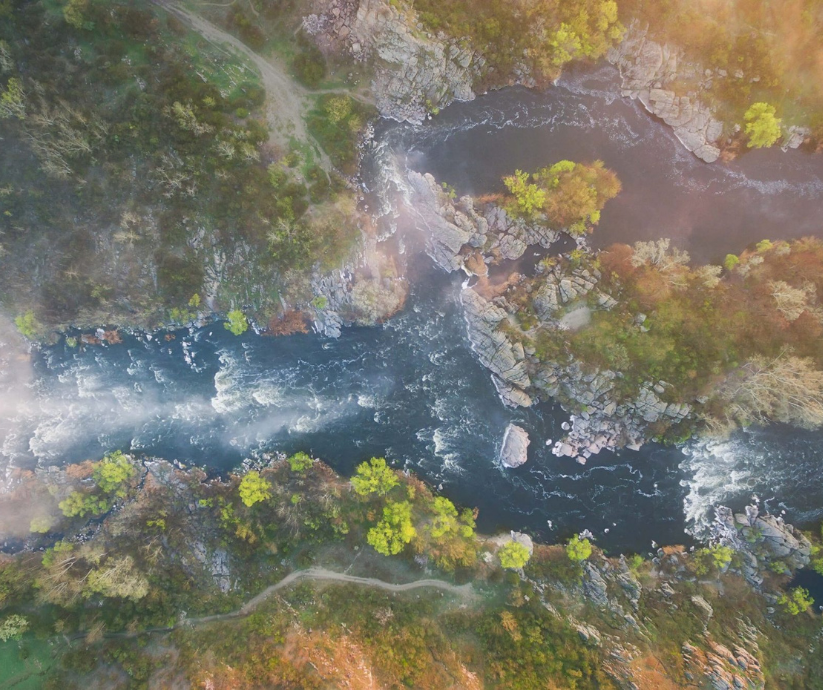The National Nuclear Energy Generating Company Energoatom (hereinafter – Energoatom) plans to complete the construction of the Tashlytska pumped storage power plant (PSPP), which is located within the environmental protection areas.
The declared planned activity involves a gradual rise in the water level in the Oleksandrivske reservoir. This may cause irreversible damage to the unique ecosystem of the national nature park Buzky Gard and the regional landscape park Granitne-stepove Pobuzhzhia. Archaeological monuments of settlements and burial sites of the Neolithic-Bronze Age, which are an integral part of the cultural heritage of the area, will also be flooded.
In that material, we tell about the potential danger for the environment and residents of the surrounding communities and whether it can be prevented.
What is the problem
It became known about the plan to launch new equipment at the Tashlytska PSPP as early as 2021. In 2022, the Ministry of Ecology and Natural Resources refused to accept the results of the Environmental Impact Assessment (EIA), as the materials contained inaccurate and incomplete information, and the content of the report contradicted the legislation of Ukraine on nature reserves and biodiversity. The completion of the power plant involved a gradual increase in the level of the Oleksandrivske reservoir to 20.7 meters.
Subsequently, Energoatom started a similar EIA procedure, which has a difference in the rise of the water level. The new project for the completion of the pumped storage power plant provides that after the completion of the construction, the water level in the Oleksandrivske reservoir will rise to 16.9 meters. This project is indicated by the company as an alternative.
“I emphasize that previously planned activity cannot be an alternative to the existing one, since it did not receive an EIA conclusion on the admissibility of such activity, and therefore is not ecologically justified,” – emphasizes Yuliia Kvitka, a specialist in environmental impact assessment of the Ecoclub.
These activities are planned within the boundaries of the nature reserve fund: National Nature Park Buzky Gard, regional landscape park Granitne-stepove Pobuzhzhia, an ichthyological reserve of local importance Olexandrivskyi and the territory of the Emerald Network.
Nature is in danger
“The proposed completion of the construction will negatively affect land resources, unique flora, and fauna and will also create new threats for residents of nearby communities. At the same time, the archaeological and cultural heritage will suffer. This is a vivid example of the future inevitable consequences for the vulnerable ecosystem of protected areas,” says Yuliia Kvitka.
National Nature Park Buzky Gard is a natural, historical, and cultural complex of Ukraine, located among the canyons of the Mykolaiv region. Granitno-stepove Pobuzhjia is a natural mountain-steppe area and a complex of archaeological and historical monuments of the Zaporizhzhya Sich era. The territories of the Buzky Gard and the Regional Landscape Park Granitno-stepove Pobuzhjia intersect, and a certain part of them belongs to the Emerald Network. Therefore, they have national and international nature protection statuses.
These nature-protected territories have unique ecosystems with a significant number of endangered species of plants and animals of mountain-alpine and Mediterranean origin. More than 100 representatives of flora and fauna of this territory are listed in the Red Book of Ukraine and the European Red List.
Among the rare plants are lilac carnations, lilac and red tulips, snowdrops, tall mistletoe, steppe almond, barberry bushes, honeysuckle, lily of the valley, and dream grass. Among the birds and animals – are gray and red herons, great and small hawks, common kestrel, quail, owl, weasel, ermine, raccoon dog, European mink, etc.
Buzky Gard is also characterized by a unique variety of fish species: there are more than 35 species. And the territory of Pobuzhzhia is home to nine thousand species of insects.
What is wrong with the EIA report: Ecoclub’s remarks
· The new EIA report does not contain cartographic materials and a description of planned works on the territory of the nature-protected territory:
“If there is no cartographic data on nature-protected areas where certain activities are planned, then the company does not assume responsibility for the protection of this area,” says Yuliia Kvitka.
· In addition, the information on the noise impact on the environment during the period of operation of the object is unreliable and contradictory.
In the section of the report Air environment. Noise conditions indicates that the level of noise pollution at the border of residential buildings will be 36-44 dBA (from existing noise sources). However, on page 76 it says that the total noise level from all sources will be 36-44 dBA. In addition, five more noise sources will be added to the existing noise sources during the planned activity.
· Energoatom did not provide calculations regarding the noise impact neat the neighboring residential area and the Iskra health and rehabilitation complex during the preparation, construction, and operation of the PSPP.
· The report contains unreliable and contradictory information regarding the impact on air quality and the distance to the nearest residential building.
The report states that the planned activity will not cause an affect impact on the state of the atmospheric air. However, on page 50 it is stated that air pollution due to the activity will still occur (this is indicated in table 1.5.1.2.1 of the report).
Pages 14, 19, 75 show different distances to residential buildings.
· The report does not contain information about the position of the objects of the nature reserve fund in relation to the planned activities of the PSPP within their territories.
· The authors of the report did not assess the impact on plant life.
The report contains information about the forest clearing of the reservoir bowl. However, at the same time, the document does not contain a description of forest clearing works, equipment and area. In addition, there is no information about the number of trees, their species composition. There is also no description of the potential consequences for the environment after forest clearing.
· The report does not contain information on the volumes of water consumption and drainage during the operation of the plant.
Ecoclub’s position
We propose that the Ministry of Environmental Protection and Natural Resources of Ukraine should refuse to accept the EIA report on the completion of the construction of the Tashlytska PSPP.
In addition, the Ukrainian government should reconsider its support for the completion of the Tashlytska PSPP, and make the protection of the park’s vulnerable ecosystem a priority.
We note that the public can control the transparency of obtaining permits and passing the procedure of objects potentially dangerous for the environment and people. Environmental impact assessment is a tool that involves public participation in decision-making. How to participate in this process, read here.
Read the full version of the comments and suggestions to the EIA report here.











